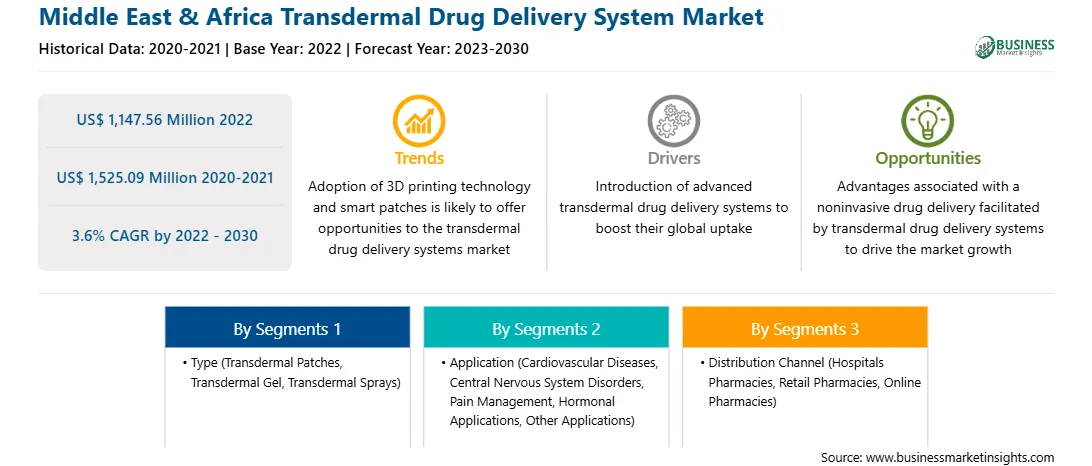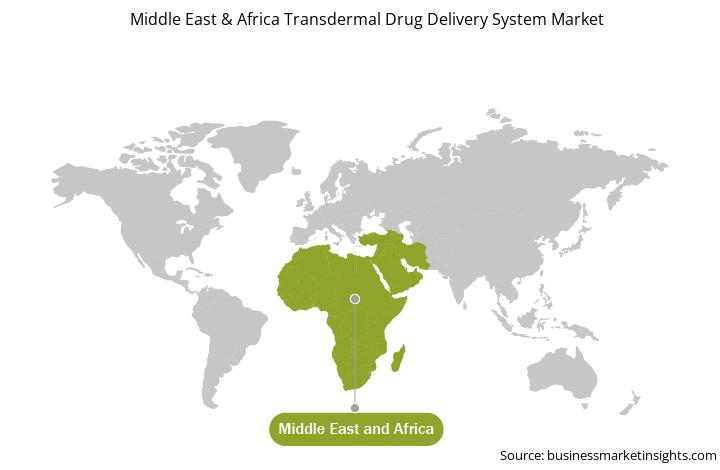The Middle East & Africa transdermal drug delivery system market is expected to grow from US$ 1,147.56 million in 2022 to US$ 1,525.09 million by 2030. It is estimated to register a CAGR of 3.6% from 2022 to 2030.
Cardiovascular diseases (CVDs) such as angina, atherosclerosis, pectoris, and acute myocardial infarction are among the common causes of mortality in the world. According to the WHO, CVDs are the major cause of ~17.9 million deaths worldwide every year. Many medicines are commercially available for the treatment of CVDs but conventional capsules and tablets are unable to effectively control the ailment. This underlines the need for novel drug delivery systems providing prolonged drug bioavailability and targeted drug delivery to the affected areas of the cardiovascular system. Transdermal drug delivery systems offer many advantages over regular orally administered drugs to treat cardiovascular diseases. Transdermal patches, encompassing drug particles, are applied on the skin surface. A cardiac patch provides an excellent platform for cell engraftment improvement. For example, a vascularized cardiac patch developed recently shows promising potential for treating ischemic heart injuries. Nitroglycerin transdermal patches are used to prevent angina (chest pain) episodes in people with coronary artery disease. They work by relaxing the blood vessels and reducing the stress on the heart, thereby lowering the need for oxygen. However, these patches cannot be used to treat angina attacks that have already begun.
Rivastigmine patch is used to treat dementia (memory loss) associated with mild, moderate, or severe Alzheimer's disease or mild-to-moderate dementia associated with Parkinson's disease. Rivastigmine and donepezil are cholinesterase inhibitors exhibiting a dose-response relationship, with higher doses of the drugs demonstrating greater efficacy. It is a small, lipophilic, and hydrophilic molecule that is chemically well-suited for transdermal delivery.
Diabetes is a life-threatening chronic disease having no specialized cure. Both types of diabetes can lead to various problems in different body parts and increase the overall risk of premature death. According to the International Diabetes Federation (IDF) Diabetes Atlas 10th edition reports, in 2021, globally 537 million adults (20-79 years) were diabetic, and the number is likely to reach 643 million by 2030 and 783 million by 2045. Exogenous insulin is usually administered subcutaneously for diabetes management. However, the recent attention toward a smart patch that delivers insulin when needed, simplifying insulin intake and activating targeted action.
Thus, the increasing incidences of chronic diseases such as cardiovascular diseases, Alzheimer's disease, and diabetes bolster the growth of the transdermal drug delivery system market.
The transdermal drug delivery system market in the MEA is segmented into the UAE, Saudi Arabia, South Africa, and the Rest of MEA. The market growth is expected to grow due to the high prevalence of chronic diseases, increasing healthcare expenditure, and rising R&D activities across the region. Moreover, the rising demand for technologically advanced medical devices helps propel the market growth during the forecast period. According to a study "Noncommunicable diseases and health system responses in Saudi Arabia: focus on policies and strategies. A qualitative study," published by Health Research Policy and Systems in 2022, noncommunicable diseases (NCDs), particularly diabetes, CVD, and other chronic diseases, are responsible for an increasing disease and economic burden in Saudi Arabia. According to Saudi Health Ministry statistics, cardiovascular diseases account for 37% of all deaths in Saudi Arabia. According to the United Nations Population Fund (UNFPA), Saudi Arabia is expected to experience a five-fold rise in the aging population from 2 million (5.9%) in 2020 to 10.5 million by 2050 (23.7%). The geriatric population is prone to health conditions such as cardiovascular diseases, lung infections, and diabetes. According to Global Burden of Disease data published in 2020, Saudi Arabia has a high prevalence of noncommunicable diseases such as stroke, heart disease, kidney disease, COPD, and diabetes. Furthermore, deaths related to diabetes increased by ~79%, chronic kidney disease by 41.2%, and stroke by 27.6% between 2009 and 2019. Thus, the high prevalence of mentioned diseases fuels the demand for transdermal drug delivery systems, thereby boosting the market growth.
Saudi Arabia partnered with the UK academic and research institutions in 2019 for a US$1.6 billion initiative to enhance the Kingdom's domestic research and development capabilities. In Saudi Arabia, due to the increasing demand for healthcare services, the rising government initiatives favor increased participation from the private sector for their expansion. Thus, the rising prevalence of cardiovascular diseases in the population and the rise in healthcare expenditure in Saudi Arabia play a vital role in the growth of the transdermal drug delivery system market.

Strategic insights for the Middle East & Africa Transdermal Drug Delivery System provides data-driven analysis of the industry landscape, including current trends, key players, and regional nuances. These insights offer actionable recommendations, enabling readers to differentiate themselves from competitors by identifying untapped segments or developing unique value propositions. Leveraging data analytics, these insights help industry players anticipate the market shifts, whether investors, manufacturers, or other stakeholders. A future-oriented perspective is essential, helping stakeholders anticipate market shifts and position themselves for long-term success in this dynamic region. Ultimately, effective strategic insights empower readers to make informed decisions that drive profitability and achieve their business objectives within the market.

| Report Attribute | Details |
|---|---|
| Market size in 2022 | US$ 1,147.56 Million |
| Market Size by 2030 | US$ 1,525.09 Million |
| Global CAGR (2022 - 2030) | 3.6% |
| Historical Data | 2020-2021 |
| Forecast period | 2023-2030 |
| Segments Covered |
By Type
|
| Regions and Countries Covered | Middle East and Africa
|
| Market leaders and key company profiles |
The geographic scope of the Middle East & Africa Transdermal Drug Delivery System refers to the specific areas in which a business operates and competes. Understanding local distinctions, such as diverse consumer preferences (e.g., demand for specific plug types or battery backup durations), varying economic conditions, and regulatory environments, is crucial for tailoring strategies to specific markets. Businesses can expand their reach by identifying underserved areas or adapting their offerings to meet local demands. A clear market focus allows for more effective resource allocation, targeted marketing campaigns, and better positioning against local competitors, ultimately driving growth in those targeted areas.

The Middle East & Africa transdermal drug delivery system market is segmented into type, application, distribution channel, and country.
Based on type, the Middle East & Africa transdermal drug delivery system market is segmented into transdermal patches, transdermal gel, transdermal sprays, and others. The transdermal gel segment held the largest share of the Middle East & Africa transdermal drug delivery system market in 2022. The transdermal patches is further sub segmented into drug-in-adhesive patches, matrix patches, reservoir membrane patches, and vapor patches.
In terms of application, the Middle East & Africa transdermal drug delivery system market is categorized into cardiovascular diseases, central nervous system disorders, pain management, hormonal applications, and other applications. The pain management segment held the largest share of the Middle East & Africa transdermal drug delivery system market in 2022. The pain management is further sub segmented into opioid and non-opioid. The hormonal applications is further sub segmented into transdermal estrogen & progesterone therapy and testosterone replacement.
By distribution channel, the Middle East & Africa transdermal drug delivery system market is segmented into hospitals pharmacies, retail pharmacies, online pharmacies, and others. The hospitals pharmacies segment held the largest share of the Middle East & Africa transdermal drug delivery system market in 2022.
Based on country, the Middle East & Africa transdermal drug delivery system market is categorized into the UAE, Saudi Arabia, South Africa, and the Rest of Middle East & Africa. Saudi Arabia dominated the Middle East & Africa transdermal drug delivery system market in 2022.
Boehringer Ingelheim International GmbH, GSK Plc, Hisamitsu Pharmaceutical Co Inc, Johnson & Johnson, Novartis AG, and Viatris Inc are some of the leading companies operating in the Middle East & Africa transdermal drug delivery system market.
1. Boehringer Ingelheim International GmbH
2. GSK Plc
3. Hisamitsu Pharmaceutical Co Inc
4. Johnson & Johnson
5. Novartis AG
6. Viatris Inc
The Middle East & Africa Transdermal Drug Delivery System Market is valued at US$ 1,147.56 Million in 2022, it is projected to reach US$ 1,525.09 Million by 2030.
As per our report Middle East & Africa Transdermal Drug Delivery System Market, the market size is valued at US$ 1,147.56 Million in 2022, projecting it to reach US$ 1,525.09 Million by 2030. This translates to a CAGR of approximately 3.6% during the forecast period.
The Middle East & Africa Transdermal Drug Delivery System Market report typically cover these key segments-
The historic period, base year, and forecast period can vary slightly depending on the specific market research report. However, for the Middle East & Africa Transdermal Drug Delivery System Market report:
The Middle East & Africa Transdermal Drug Delivery System Market is populated by several key players, each contributing to its growth and innovation. Some of the major players include:
The Middle East & Africa Transdermal Drug Delivery System Market report is valuable for diverse stakeholders, including:
Essentially, anyone involved in or considering involvement in the Middle East & Africa Transdermal Drug Delivery System Market value chain can benefit from the information contained in a comprehensive market report.